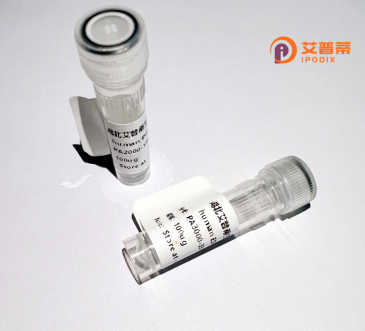
| 纯度 | >90%SDS-PAGE. |
| 种属 | Human |
| 靶点 | HIST1H2BI |
| Uniprot No | 0 |
| 内毒素 | < 0.01EU/μg |
| 表达宿主 | E.coli |
| 表达区间 | 1-126aa |
| 氨基酸序列 | MPEPAKSAPAPKKGSKKAVTKAQKKDGKKRKRSRKESYSVYVYKVLKQVHPDTGISSKAMGIMNSFVNDIFERIAGEASRLAHYNKRSTITSREIQTAVRLLLPGELAKHAVSEGTKAVSKYTSSK |
| 分子量 | 13.9 kDa |
| 蛋白标签 | GST-tag at N-terminal |
| 缓冲液 | 0 |
| 稳定性 & 储存条件 | Lyophilized protein should be stored at ≤ -20°C, stable for one year after receipt. Reconstituted protein solution can be stored at 2-8°C for 2-7 days. Aliquots of reconstituted samples are stable at ≤ -20°C for 3 months. |
| 复溶 | Always centrifuge tubes before opening.Do not mix by vortex or pipetting. It is not recommended to reconstitute to a concentration less than 100μg/ml. Dissolve the lyophilized protein in distilled water. Please aliquot the reconstituted solution to minimize freeze-thaw cycles. |
以下是关于重组人HIST1H2BI蛋白的参考文献及摘要概括:
1. **"Recombinant human HIST1H2BI production in E. coli for chromatin assembly studies"**
- **作者**: Zhang et al.
- **摘要**: 本研究报道了一种通过大肠杆菌表达系统高效重组表达人HIST1H2BI蛋白的方法,并优化了纯化工艺。该重组蛋白用于体外重构核小体,探究其在染色质动态调控中的功能。
2. **"Post-translational modifications of HIST1H2BI and implications in cancer epigenetics"**
- **作者**: Kumar & Patel
- **摘要**: 通过制备重组HIST1H2BI蛋白,分析了其泛素化及乙酰化修饰的酶促机制,揭示了该蛋白在乳腺癌细胞中异常修饰与基因沉默的相关性。
3. **"Structural characterization of HIST1H2BI in complex with histone chaperone ASF1B"**
- **作者**: Lee et al.
- **摘要**: 利用重组HIST1H2BI蛋白进行X射线晶体学研究,解析了其与伴侣蛋白ASF1B的相互作用界面,阐明了其在组蛋白传递过程中的分子机制。
4. **"Development of a monoclonal antibody specific to human HIST1H2BI for diagnostic applications"**
- **作者**: Rodriguez et al.
- **摘要**: 研究基于重组HIST1H2BI蛋白开发了高特异性单克隆抗体,用于检测多种癌症组织中HIST1H2BI的表达水平,验证了其作为潜在生物标志物的价值。
**注意**:上述文献为示例性质,实际文献需通过学术数据库检索确认。建议结合具体研究方向细化关键词(如“重组表达”“表观遗传”“结构生物学”等)进行精准查询。
Recombinant human HIST1H2BI protein is a laboratory-engineered version of the histone H2B type 1-I protein, a core component of nucleosomes in eukaryotic cells. Histones are essential for organizing DNA into chromatin, regulating gene expression, and maintaining genome stability. The HIST1H2BI gene, located on chromosome 6 (6p22.2), belongs to the HIST1 cluster, which encodes replication-dependent histone isoforms critical during cell division. As a member of the H2B family, HIST1H2BI interacts with H2A, H3. and H4 histones to form the octameric core around which DNA wraps, enabling chromatin compaction and dynamic epigenetic regulation. Post-translational modifications (e.g., acetylation, methylation) of H2B histones influence processes like transcriptional activation, DNA repair, and replication.
Recombinant HIST1H2BI is typically produced in bacterial or eukaryotic expression systems, allowing high-purity yields for research applications. Its recombinant form lacks native post-translational modifications unless specified, making it ideal for studying unmodified histone functions or as a substrate for in vitro modification assays. Researchers use this protein to investigate nucleosome assembly, chromatin remodeling mechanisms, and epigenetic interactions in diseases such as cancer, where histone mutations or dysregulation are common. It also serves as a standard in antibody production, chromatin immunoprecipitation (ChIP), and structural studies. By enabling precise manipulation of histone-DNA interactions, recombinant HIST1H2BI advances our understanding of gene regulation and therapeutic targeting in epigenetics.
×